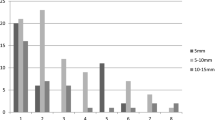Abstract
Purpose
Although laparoscopic surgery in children has expanded in recent years. Laparoscopic hernia repair in children is still debatable. We aimed to summarize and describe our results of laparoscopic inguinal hernia repair and techniques among children.
Methods
Between March 2011 and April 2013, 98 children (67 male, 31 female) underwent laparoscopic inguinal hernia repair at the department of surgery. The clinical outcomes were collected retrospectively.
Results
The mean follow-up period was 22.6 months. Twelve patients were ex-premature infants and a contralateral patent processus vaginalis (PPV) was present in 37 of the 91 unilateral inguinal hernia patients. There were two postoperative complications (transient hydrocele, umbilical port site infection). The mean operative time was 46 min. Recurrence, metachronous hernia and testicular atrophy were not observed during the follow-up period.
Conclusions
Our preliminary experiences suggest that the laparoscopic purse-string suture of internal inguinal opening of hernia sac could be a safe, effective, and reliable alternative for management of pediatric inguinal hernia.




Similar content being viewed by others
References
Wang KS (2012) Assessment and management of inguinal hernia in infants. Pediatrics 130:768–773
Kl Chan, Hui WC, Tam PK (2005) Prospective randomized single-center, single-blind comparison of laparoscopic vs open repair of pediatric inguinal hernia. Surg Endosc 19:927–932
Schier F (2006) Laparoscopic inguinal hernia repair-a prospective personal series of 542 children. J Pediatr Surg 41:1081–1084
Yj Boo, Han HJ, Ji WB et al (2012) Laparoscopic hernia sac transection and intracorporeal ligation show very low recurrence rate in pediatric inguinal hernia. J Laparoendosc Adv Surg Tech A 22:720–723
Mk Abraham, Nasir AA, Puzhankara R et al (2012) Laparoscopic inguinal hernia repair in children: a single-centre experience over 7 years. Afr J Paediatr Surg 9:137–139
Chang YT, Lin JY, Lee JY et al (2012) Comparative mid-term results between inguinal herniotomy and single-port laparoscopic herniorrhaphy for pediatric inguinal hernia. Surg Laparosc Endosc Percutan Tech 22:526–531
Guner YS, Emami CN, Chokshi NK et al (2010) Inversion herniotomy: a laparoscopic technique for female inguinal hernia repair. J Laparoendosc Adv Surg Tech A 20:481–484
Molina VME, Sanchez AA, Aguilar CR (2012) Laparoscopic assisted percutaneous treatment of inguinal hernia in infants. Cir Pediatr 25:4–8
Puri P, Guiney EJ, O’Donnell B (1984) Inguinal hernia in infants: the fate of the testis following incarceration. J Pediatr Surg 19:44–46
Rescorla FJ, Grosfeld JL (1984) Inguinal hernia repair in the perinatal period and early infancy: clinical considerations. J Pediatr Surg 19:832–837
Schier F (1998) Laparoscopic herniorrhaphy in girls. J Pediatr Surg 33:1495–1497
Janetschek G, Reissigl A, Bartsch G (1994) Laparoscopic repair of pediatric hydroceles. J Endourol 8:415–417
Marte A, Sabatino MD, Borrelli M et al (2009) Decreased recurrence rate in the laparoscopic herniorraphy in children: comparison between two techniques. J Laparoendosc Adv Surg Tech A 19:259–262
Yip KF, Tam PK, Li MK (2004) Laparoscopic flip-flap hernioplasty: an innovative technique for pediatric hernia surgery. Surg Endosc 18:1126–1129
Harrison MR, Lee H, Albanese CT et al (2005) Subcutaneous endoscopically assisted ligation (SEAL) of the internal ring for repair of inguinal hernias in children: a novel technique. J Pediatr Surg 40:1177–1180
Rowe MI, Copelson LW, Clatworthy HW (1969) The patent processus vaginalis and the inguinal hernia. J Pediatr Surg 4:102–107
Holcomb GW 3rd, Morgan WM, Brock JW et al (1996) Laparoscopic evaluation for contralateral patent processus vaginalis: Part II. J Pediatr Surg 31:1170–1173
Geisler DP, Jegathesan S, Parmley MC et al (2001) Laparoscopic exploration for the clinically undetected hernia in infancy and childhood. Am J Surg 182:693–696
McGregor DB, Halverson K, McVay CB (1980) The unilateral pediatric inguinal hernia: Should the contralateral side by explored? J Pediatr Surg 15:313–317
Ein SH, Njere I, Ein A (2006) Six thousand three hundred sixty-one pediatric inguinal hernias: a 35-year review. J Pediatr Surg 41:980–986
Zendejas B, Zarroug AE, Erben YM et al (2010) Impact of childhood inguinal hernia repair in adulthood: 50 years of follow-up. J Am Coll Surg 211:762–768
Gilbert M, Clatworthy HW Jr (1959) Bilateral operations for inguinal hernia and hydrocele in infancy and childhood. Am J Surg 97:255–259
Koivusalo AI, Korpela R, Wirtavuori K et al (2009) A single-blinded, randomized comparison of laparoscopic versus open hernia repair in children. Pediatrics 123:332–337
Yang C, Zhang H, Pu J et al (2011) Laparoscopic vs open herniorrhaphy in the management of pediatric inguinal hernia: a systemic review and meta-analysis. J Pediatr Surg 46:1824–1834
Dutta S, Albanese C (2009) Transcutaneous laparoscopic hernia repair in children: a prospective review of 275 hernia repairs with minimum 2-year follow-up. Surg Endosc 23:103–107
Schier F, Montupet P, Esposito C (2002) Laparoscopic inguinal herniorrhaphy in children: a three-center experience with 933 repairs. J Pediatr Surg 37:395–397
Phelps S, Agrawal M (1997) Morbidity after neonatal inguinal herniotomy. J Pediatr Surg 32:445–447
Nagraj S, Sinha S, Grant H et al (2006) The incidence of complications following primary inguinal herniotomy in babies weighing 5 kg or less. Pediatr Surg Int 22:500–502
Conflict of interest
W. C., D. L., Y. B., B. K., M. O, declares no conflict of interest.
Author information
Authors and Affiliations
Corresponding author
Rights and permissions
About this article
Cite this article
Lee, D.Y., Baik, Y.H., Kwak, B.S. et al. A purse-string suture at the level of internal inguinal ring, taking only the peritoneum leaving the distal sac: is it enough for inguinal hernia in pediatric patients?. Hernia 19, 607–610 (2015). https://doi.org/10.1007/s10029-015-1348-7
Received:
Accepted:
Published:
Issue Date:
DOI: https://doi.org/10.1007/s10029-015-1348-7




